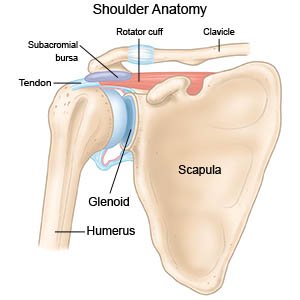Shoulder Impingement Syndrome
Medically reviewed by Drugs.com. Last updated on Apr 6, 2025.
What is shoulder impingement syndrome?
Shoulder impingement syndrome (SIS) happens when the tendons or bursa become trapped between bones of your shoulder joint. You have pain when you reach over your head or lie on the shoulder while sleeping. You may also have pain when you move your arm out to the side or behind your body.
 |
What can cause SIS?
- Repeated use as in swimming, tennis, and throwing a ball
- Trauma such as a fall, in which you landed on your shoulder
- Osteoarthritis in your shoulder
- Weakness in your rotator cuff and shoulder blade muscle
- The bursa or ligaments in your shoulder become inflamed and thick
How is SIS diagnosed?
Your healthcare provider will ask about your symptoms. He or she will ask about your work and hobbies. Your healthcare provider will have you move your arm and shoulder in different directions. He or she will do tests to check the strength and movement of your shoulder. You may need an x-ray to check for bone spurs or arthritis.
Drugs used to treat this and similar conditions
Tylenol
Tylenol is a pain reliever and a fever reducer used to treat many conditions such as headaches ...
Dilaudid
Dilaudid (hydromorphone) is a narcotic pain reliever used to treat moderate to severe pain ...
Omvoh
Omvoh is used to treat moderate to severe ulcerative colitis or Crohn's disease in adults. This ...
Qutenza
Qutenza patches are used to treat neuropathic pain associated with postherpetic neuralgia and ...
OxyContin
OxyContin (oxycodone) is an opioid pain reliever used to treat moderate to severe pain. Includes ...
Percocet
Percocet (acetaminophen and oxycodone) is used to relieve moderate to severe pain. Includes ...
Acetaminophen/hydrocodone
The combination of hydrocodone and acetaminophen is used to relieve moderate to severe pain ...
Hydrocodone
Hydrocodone (Hysingla ER and Zohydro ER) is used for around-the-clock treatment of severe pain ...
Oxycodone
Oxycodone is an opioid analgesic used to treat moderate to severe pain; it has a high potential for ...
Acetaminophen
Acetaminophen is a widely used pain reliever and fever reducer for conditions like headaches ...
What is the treatment for SIS?
It is important that SIS is treated to avoid complications including rotator cuff tears. Treatments include the following:
- Rest will help your shoulder pain. Limit reaching above your shoulder's height.
- Apply ice on your shoulder for 20 minutes 1 or 2 times in a day. Use an ice pack, or put crushed ice in a plastic bag. You may also use a bag of frozen peas or corn. Cover the bag with a towel. Ice decreases swelling and pain.
- Physical therapy will teach exercises to stretch and strengthen your shoulder. Exercises will also help decrease pain.
- Medicines may be given to relieve pain and swelling.
- Surgery may be needed if your rotator cuff is torn or other treatments do not work.
When should I seek immediate care?
- Your shoulder, arm, hand, or fingers turn bluish or pale, or feel cold or numb.
- Your pain gets worse, even after rest and medicine.
- You cannot move your fingers.
When should I call my doctor?
- You have questions about your condition or care.
Care Agreement
You have the right to help plan your care. Learn about your health condition and how it may be treated. Discuss treatment options with your healthcare providers to decide what care you want to receive. You always have the right to refuse treatment. The above information is an educational aid only. It is not intended as medical advice for individual conditions or treatments. Talk to your doctor, nurse or pharmacist before following any medical regimen to see if it is safe and effective for you.© Copyright Merative 2025 Information is for End User's use only and may not be sold, redistributed or otherwise used for commercial purposes.
Further information
Always consult your healthcare provider to ensure the information displayed on this page applies to your personal circumstances.
